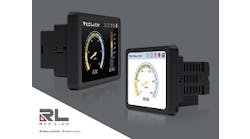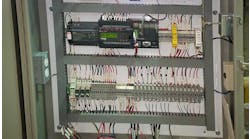Universal Panel Meter is configurable for measurement, display or control
The Universal Panel Meter (UPM) series is the culmination of 40 years that Dr. Otto Fest, president and owner of Otek, has dedicated to current loop power. The UPM includes automatic tricolor alphanumeric display and field configurability for analog and digital inputs, data logging and control.
Call 520/748-7900, email [email protected] or browse to www.otekcorp.com.
“In 1974, I started tinkering for a customer who asked me to replace an old meter,” says Fest. “My field was solid-state electronics design, and I was intrigued by the amount of energy wasted in the current loop. I came up with the first LCD loop-powered meter in 1974; that had a 12-V burden. What held me back was that our suppliers were not developing new technologies to do what I wanted to do, which was 100% loop or signal power to compete with and replace the analog meter invented in 1893 by Sir Edward Weston.”
It wasn’t until a few years ago when Fest came across some high-efficiency LEDs and some nanotechnology, which allowed him to develop the New Technology Meter (NTM) and UPM series, with tricolor LEDs and looped power. “After the NTM proved to be successful, I needed to get back to the digital panel meter/counter market, but I couldn’t find an LED to satisfy my needs,” he says. “I went to China and worked with them to design a custom display utilizing almost organic LED technology, and that allowed me to come up with the UPM.”
Also read: Panel meters take control
All UPM models use the same patented technology, issued April 9, 2015, as well as patented hardware and firmware used in Otek’s NTM series. The UPM series’ features include automatic signal fail detection, indication and isolated serial transmission with run time stamp and unit ID, isolated retransmission (4-20 mA) and universal power input (5-32 Vdc and 90-265 Vac) or powerless (signal power). The UPM also offers math functions such as x-y tables, polynomials and log/antilog functions. UPM signal and external power series also feature isolated serial USB, RS-485 or Ethernet μSD memory card to 32 GB, four open collector transistors per channel and four SPDT relays per channel.
“The UPM allows you to configure the units via your laptop for control or PID,” says Fest. “It’s an instrument that can be used for many applications without having to order a specific part number. The UPM can accept analog or digital signals and displays them in alphanumeric form. It also has solid-state relays and analog outputs. Like the NTM, it has isolated serial communications. I had to be able to package it in the same traditional packages that the industry was used to and eliminate our customers’ biggest obstacles, which are reengineering, rewiring and emergency-backup-power redesign when upgrading control rooms. I had to make the NTM and UPM plug-and-play.”
The UPM can measure analog and digital signals, it can be used as a slave display or message center with SCADA, DCS or PLC, and it can be used as a controller or paperless recorder. “The unit doesn’t have to be ordered for one specific purpose,” Fest explains. “It can be modified via the serial port to perform any options originally selected. That’s why we call it Universal Panel Meter. That’s where our configurator comes into play. It automatically configures the part as per your selections. And it provides pricing and a user’s manual, customized specifically to the part number that you enter.”
The units include Otek’s Powerless technology, which means units don’t require any power other than what the signal can produce, just like analog meters, which is typically 10-80 mW per channel. These options cannot drive relays or analog outputs, but they can drive the isolated open collector transistors. “Using the Powerless technology, when the unit detects a lost signal, immediately a distress message is transmitted via the serial port to supervisory equipment and the display, for about 20-30 seconds, flashing the message, ‘INPT FAIL.’ You cannot get something for nothing.”
The UPM is ideal for applications with an isolated signal that needs to be monitored. “If you have a multitude of parameters or machinery you need to control, your best bet is to go with a SCADA system,” advises Fest. “In a nuclear facility, for example, where you’re monitoring Volts, Watts, Amps and/or Hertz, on a three-phase system, the operator can be overwhelmed by the amount of information he has to look at and record. Traditionally, a given reactor is controlled by control room instrumentation. A portion of that information is controlled by a given operator. And that operator can be in charge of 40-50 meters. When you put all of that on a flatscreen, you’re talking about 300 parameters crammed into about 10 screens. Operator fatigue has become a concern in the industry. The operator now needs a break every two or three hours.”
The UPM can monitor and control up to five isolated parameters. “They can be independently assigned to control a process or be a slave,” he explains. “You can override the relays and analog output via the serial communications. It gives the operator more freedom, but it gives the engineer more choices to place the UPM in the factory, instead of one multifunction display in a control room that is remote.”
Fest also considered integration with existing equipment when he developed the UPM. “To implement a new instrument into control rooms in the nuclear industry, for example, it can cost tens of millions of dollars because digital components need to be integrated with the analog equipment,” he explains. “We made a unit that can be customized to replace form, fit and function of existing units in the field and customized to the same wiring that the plant or installation might have, so they don’t have to redesign the emergency power generator or wiring system. The customer can replace one unit at a time or all 500 units at once.”
Each UPM unit uses 1% of the energy required by a digital meter, says Fest. “The lowest we can go in power consumption today is 10 mW per channel, so the customer doesn’t have to redesign its power source. They don’t have to shut down the system to replace it with our unit. As long as your signal can generate 10 mW, you can replace any analog with the UPM or NTM. That’s why we tell our customers, ‘If we don’t have it, we’ll make it.’”
To download a preliminary spec sheet on the Universal Panel Meter, click here.







